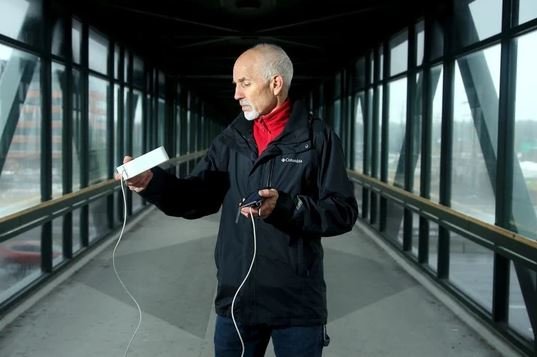Egan: They'd like to clear the air — pollution in Ottawa is slowly killing us
Air pollution, according to expert estimates, will lead to more premature deaths in Ottawa this year than COVID-19.
The one problem we’ve attacked with historic lockdowns and massive societal shifts, the other with a suspicious silence.
On a rainy day on the edge of the 417, Jake Cole pulls a little white box out of a shopping bag and plugs it into a battery. It begins, almost instantly, to read the air quality by detecting particulate matter and harmful substances like nitrogen dioxide.
Cole, 71, a retired engineer, is a Sierra Club volunteer working in partnership with Ecology Ottawa to take air quality readings at strategic spots across the city, especially those close to schools, daycares and seniors residences.
While our serious smog-days seem to belong to another era, the damage caused by air pollution is still linked to 14,600 premature deaths across the country annually (Health Canada) and some 500 in Ottawa (Ontario Medical Association).
“Why should we stand by and let 500 die every year and not do anything?†asks Cole. “And we are.â€
While Ontario’s Ministry of the Environment has a permanent testing station near Wurtemburg and Rideau streets — it usually reads “low risk†— Cole captured readings maybe 10 times higher as he moved west on Rideau to heavy traffic intersections.
Similarly, he found high readings at a school bus drop-off zone in Stittsville — apparently the result of diesel exhaust — along a section of Carp Road (trucks, heavy industry near 417) and in the Montreal Road area near Highway 174.
â€I thought, this is not good. I wonder if anybody knows? I wonder if the school knows?â€
Ecology Ottawa, meanwhile, was taking a more systematic approach. It enlisted some 150 volunteers to take readings at 21 sites across the city, focusing on locations that serve vulnerable populations: daycares, schools and seniors residences. Then it took readings at 21 alternative sites that were near the originals but further from busy traffic areas.
While it is still finalizing the results, climate change organizer Emilie Grenier says on 55 per cent of all monitoring days in August and September, the pollution levels were “unhealthy for sensitive groups,†according to ingestion guidelines from the World Health Organization.
“The data collected through this study is conclusive,†reads a portion of the draft report. “There are significant spikes in poor air quality at major roadways and intersections near sensitive groups.â€
Comments
There are 0 comments on this post








